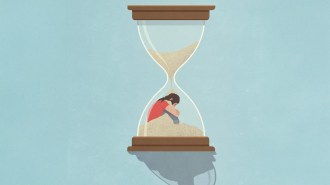Competition brings out autism’s social side
New game shows kids can appreciate what other people think and believe
Children with autism may understand more about how other people think than they’re usually given credit for. The trick to exposing this awareness, a new study finds, is to motivate these youngsters to show what they know.
In a lab game that requires a child to compete with two adults for a prize, many kids with autism demonstrate insight into how other people’s thoughts shape their behavior, say psychologist Candida Peterson of the University of Queensland in Brisbane, Australia, and her colleagues. The finding suggests that previous research testing this ability, called theory of mind, underestimates how well youngsters with autism can interpret other people’s actions, Peterson’s team reports March 19 in Developmental Science.
Studies published since 1985 have found that most high-functioning individuals with autism — those who have serious social and language problems but average or better IQs — fail a standard theory of mind test at least through adolescence. Kids without autism usually pass the test by age 5.
In the standard test, called the Sally-Anne test, children watch an experimenter play with a doll named Sally, who has a covered basket, and a doll named Anne, who has a box. Sally puts a marble in her basket and leaves. Anne moves Sally’s marble to the box. Kids with autism usually indicate that, when Sally returns, she will look for her marble in the box, failing to recognize that Sally falsely believes the marble remains in her basket.
Socially aloof children with autism may have no incentive to think about what Sally believes just because an experimenter asks them to do so, Peterson says.
The new lab game gives children an incentive to think about others’ thoughts. A child first picks a desired prize from several choices. Two adults, Dot and Midge, then enter the room and talk about wanting the same prize. The child and an experimenter hide the prize in one of three boxes as the women watch. Dot then leaves the room. Midge and the child watch the experimenter move the prize to another box. Midge departs and returns with Dot. The child then picks Dot or Midge to open a box first. If the adult opens an empty container, the child can retrieve the toy.
On two trials, 17 of 23 high-functioning kids with autism, ages 7 to 13, gave Dot the first shot both times, thereby earning themselves a prize. So did 20 of 26 typically developing 4½- to 5-year-olds. That figure fell to 13 of 24 typically developing youngsters who had just turned 4 and to four of 23 typically developing 3 year olds.
Despite the success of children with autism at exploiting Dot’s false belief, it’s easier to deploy knowledge about others’ minds in a game with clear rules than in real-world encounters. Making small talk effectively, appreciating ironic and sarcastic asides and tracking what a peer knows during a conversation can challenge even socially adept adults, Peterson says.
As individuals with autism get older, they tend to become better at sensing others’ mental states, says anthropologist and autism researcher Richard Grinker of George Washington University in Washington, D.C. The Sally-Anne test treats this ability as either present or absent.
“Theory of mind evidence is not used in diagnosing autism, because the research hasn’t developed enough yet,” Grinker says.






